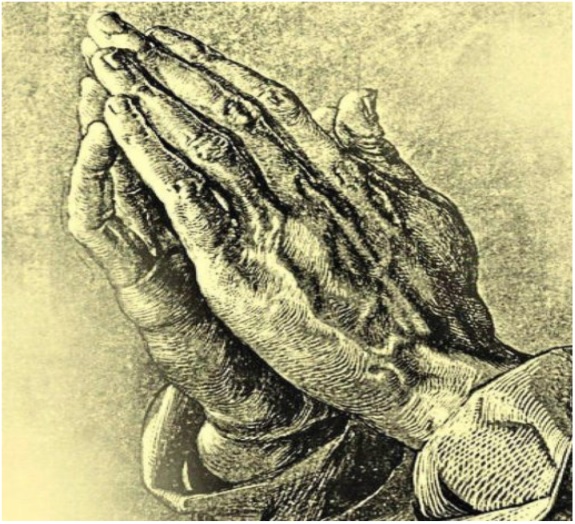
“The Praying Hands” by Albrecht Dürer (1508)
The Story of “The Praying Hands”!
By Helen Jesze, 24th November 2023
Albrecht Dürer (1471 – 1528) grew up in a village near Nürnberg, Germany, one of 18 children. Albrecht and his brother, Albert, both wanted to become famous artists, but the father did not have money for them both to study. So the brothers decided to throw a coin and whoever won, was to go to art-school for four years, and the other would finance him by working in the mine. Albrecht won and he went to Nürnberg.
It was not long before Albrecht was already getting a name for himself by his wood- carvings, oil paintings and his copperplate engravings. Albert worked in the mine and financed his studies. After four years, the young artist returned home, and the Dürer family held a festive dinner on the lawn to celebrate the triumphant homecoming. After the long and memorable meal, Albrecht rose from his honoured position at the head of the table, to propose a toast to his beloved brother, honouring him for the years of sacrifice that had enabled Albrecht to fulfil his ambition. He went on, “And now, Albert, blessed brother of mine, now it is your turn. Now you can go to Nüremberg to pursue your dream and I will take care of you.”
But Albert burst into tears. He showed them his gnarled and wounded hands; some of his fingers had been broken several times. The work had ruined his hands, he could now never be an artist! He said he suffered so much from arthritis in his right hand that he could not even hold a glass to return his brother’s toast, much less make delicate lines on parchment or canvas. It was too late now!
In honour of Albert’s sacrifice, Albrecht drew and painted for his brother what is now called The Praying Hands. He used it first of all on the right side of the central panel in a church Altarpiece, which he had been commissioned to design. Albrecht became the most famous German painter of the Renaissance. He finished over 1000 drawings und paintings, 350 wood-carvings, also over 100 copperplate engravings and etchings. However, it has been The Praying Hands which has become a world-renowned painting, copied possibly millions of times. I, myself, have a small brass plaque of it, which can be hung on the wall.
Although he never became an artist, Albert’s sacrifice and wounded broken hands have become a message to millions, reminding us of the One who paid the supreme sacrifice for us – our Lord Jesus Christ – and of his hands which were wounded and pierced for us on the cross of Calvary.
